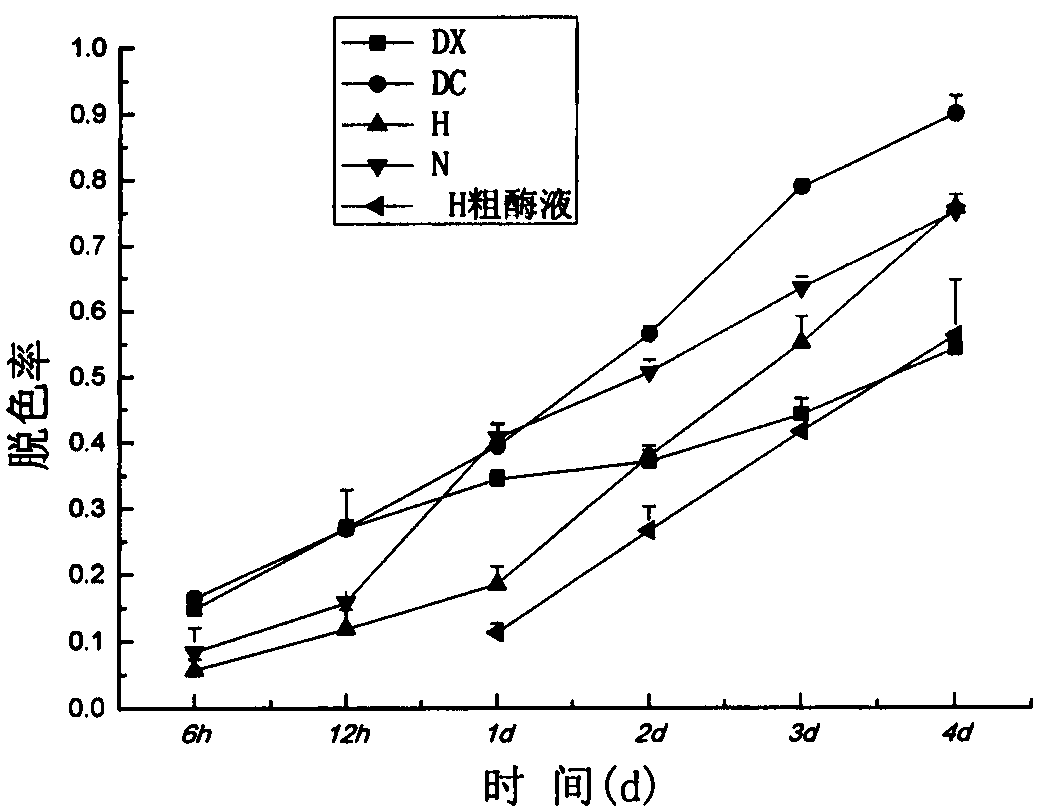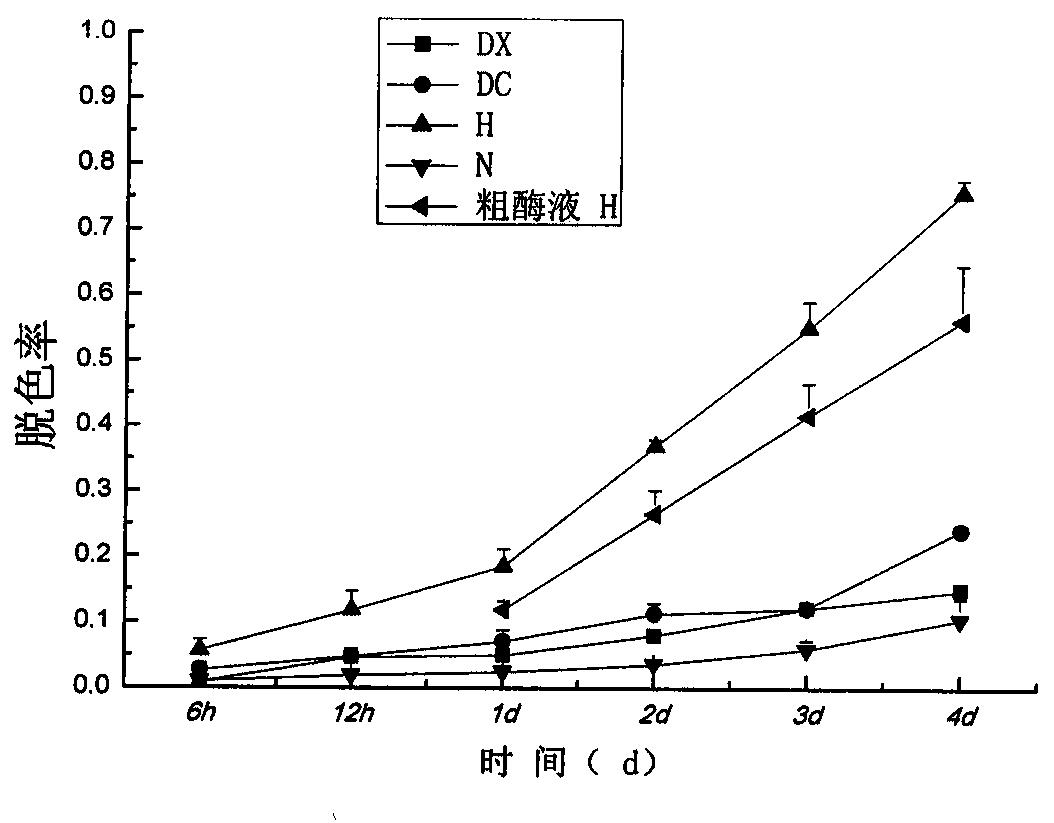A kind of separation optimization method and application of laccase-producing fungal strain
A technology of fungi and strains, applied in the field of microorganisms, to achieve the effect of good decolorization efficiency, good application prospect and potential
- Summary
- Abstract
- Description
- Claims
- Application Information
AI Technical Summary
Problems solved by technology
Method used
Image
Examples
Embodiment 1
[0046] Embodiment 1 active green 19 degradation
[0047] 1.1 Experimental reagents
[0048] Reactive Green 19 (97%), CAS No.: 61931-49-5 (Sigma R9378)
[0049] 1.2 Medium
[0050] Sucrose 30g / L, peptone 8g / L, CuSO 4 1mmol / L, MgSO 4 2g / L, KH 2 PO 4 1.5g / L, pH 6.0, FeSO 4 0.05g / L, set to 1L.
[0051] 1.3 Degradation experiment of reactive green 19
[0052]In this experiment, through uniform design optimization, the degradation rate of microorganisms to high-concentration substrates was improved, and the degradation effect of H strain Myrothecium verrucaria on 30mg / L reactive green 19 within 7 days was determined.
[0053] Preparation of bacterial suspension: On an ultra-clean laboratory bench sterilized by ultraviolet light, 5% of the inoculum of the purified Verrucous verrucosa strain was added to 100 mL of culture medium, and cultured at 28° C. and 130 r / min for 4 days.
[0054] Degradation experiment of reactive green 19: Scan the dye aqueous solution at full wavelen...
Embodiment 2
[0073] Example 2 Isolation and screening of laccase-producing strains
[0074] 2.1 Experimental materials
[0075] 2.1.1 Experimental reagents and materials
[0076] Screening strain source: Select the rhizosphere 5-10cm deep soil of Taxus chinensis in Dalian, Taxus var.
[0077] 2.1.2 Culture medium and solution preparation
[0078] (1) Enrichment medium: 30g sucrose, CuSO 4 ·5H 2 O 0.5g, NaNO 3 2g, MgSO 4 ·7H 2 O 0.5g, K 2 HPO 4 1.0g, FeSO 4 0.01g, KCl 0.5g, distilled water 1000mL, pH natural, sterilized at 115°C for 15min;
[0079] (2) Strain purification and preservation medium (PDA medium): potato 20%, glucose 2%, KH 2 PO 4 3g, agar 2%, MgSO 4 -7H 2 O 2g, VB 1 Micro-volume, set the volume to 1 L, with natural pH, sterilize at 121°C for 20 minutes, and add penicillin 50 μg / mL and streptomycin 100 μg / mL when the medium temperature drops to 70°C;
[0080] (3) Primary screening medium: PDA medium, 15g of agar, sterilized at 121°C for 20min. Add guaiacol solut...
Embodiment 3
[0104] Example 3 Taxonomic identification of laccase-producing strains in yew rhizosphere soil
[0105] 3.1 Medium, solution and buffer
[0106] (1) 10×TBE Buffer (pH8.3): Tris108g, boric acid 55g, Na 2 EDTA·2H 2 O 7.44g, dilute to 1L with deionized water, and store at room temperature.
[0107] (2) Ethidium bromide EB (10 mg / mL): 1 g of ethidium bromide, 100 mL of deionized water, and store in a brown bottle at room temperature in the dark. The working concentration is 0.5 μg / mL.
[0108] (3) Agarose (1%): 100 mL of 1×TBE buffer, 1 g of agarose, 5 μL of 10 mg / mL EB.
[0109] (4) Proteinase K: The concentration of the mother solution is 20mg / L, and it is stored at -20°C.
[0110] 3.2 Molecular identification of strains
[0111] Genomic DNA of the four strains was extracted with Universal Genomic DNA Extraction Kit Ver 5.0, and the extracted DNA was checked by agarose gel electrophoresis. The ITS of the four fungi were amplified using the universal primers ITS1-1737F: GG...
PUM
| Property | Measurement | Unit |
|---|---|---|
| decolorization rate | aaaaa | aaaaa |
Abstract
Description
Claims
Application Information
 Login to View More
Login to View More - R&D
- Intellectual Property
- Life Sciences
- Materials
- Tech Scout
- Unparalleled Data Quality
- Higher Quality Content
- 60% Fewer Hallucinations
Browse by: Latest US Patents, China's latest patents, Technical Efficacy Thesaurus, Application Domain, Technology Topic, Popular Technical Reports.
© 2025 PatSnap. All rights reserved.Legal|Privacy policy|Modern Slavery Act Transparency Statement|Sitemap|About US| Contact US: help@patsnap.com



